Warm nights and dark skies are ideal for enjoying these classic beauties.
Atop our windy hill, emerald fields turn obsidian as night sweeps her cloak across the world. A scope is waiting, the stars appear, and I’m where I belong. Summer nights are an ideal time for those of us who feel at home among the stars to lose ourselves in some of the most beautiful wonders of the deep sky.
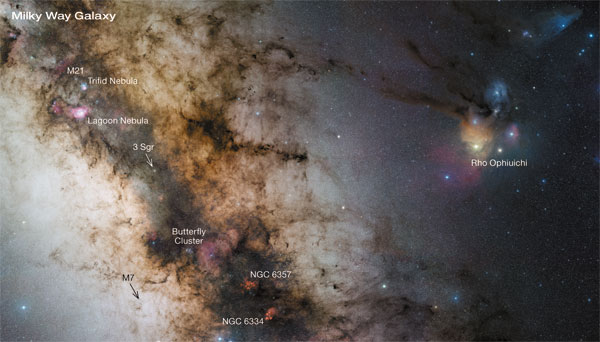
ESO/S. Guisard
Planetary nebulae are shining baubles on the dome of the sky that come in an amazing wealth of guises. One of the most famous is the Ring Nebula (M57) in Lyra, which Antoine Darquier independently discovered with a small refractor while observing the Comet of 1779. He claimed it resembles a planet that’s fading away. Although Darquier may have been the first to compare this type of nebula to a planet, it was William Herschel who coined the term “planetary nebula” several years later.
My 130-mm refractor at 23× clearly shows M57 as a very small nebula bracketed by the stars Beta (β) and Gamma (γ) Lyrae. Its ring-like structure reveals itself at just 37×. At 117× the annulus becomes distinctly oval, with ends that are dimmer than its sides. The ring’s interior isn’t as dark as the sky, creating an overall effect that John Herschel likened to “gauze stretched over a hoop.” M57 bears magnification well and appears quite stunning at 234×. Variations in brightness along the rim are accented at this higher power, and the ring’s interior appears rounder than its outer periphery, as shown in my sketch below.
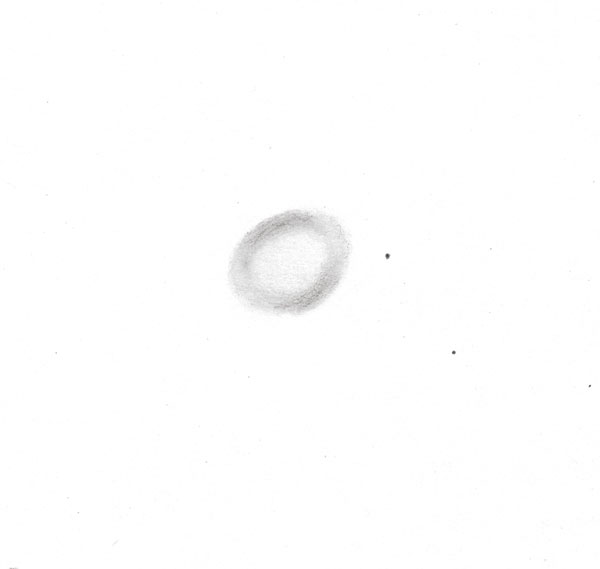
Sue French
Those who hunt more difficult game can stalk M57’s 15th-magnitude central star. Although folks have snared it through scopes as small as 8 inches in aperture, I’ve never nabbed it with anything smaller than my 14.5-inch. The key to a successful sighting lies in having exceptionally good seeing (atmospheric steadiness) and very high magnification.
Although M57 looks like a simple ring, its structure is actually much more complicated. You could think of it as a bright doughnut wrapped around the middle of a faint football, all embedded in a complex, tenuous halo. The ring structure dominates largely because we’re gazing down the pole of the planetary nebula. If we could see the Ring Nebula from the plane of its equator, it might look much like our next object, the Dumbbell Nebula (M27) in Vulpecula, the Little Fox.
Swept up by Charles Messier in 1764, M27 was the first planetary nebula ever discovered. It rests 24′ south-southeast of 14 Vulpeculae and can be recognized in my 9×50 finder. When seen through my 130-mm scope at 23×, the Dumbbell Nebula looks substantially larger than the Ring Nebula. Its bright region is shaped like an apple with the sides munched away. Protruding from the sides of this apple core is a dimmer region that turns the nebula into a football. At 48× the apple core’s rims shine brightest, and its pinched-in sides are more obvious. There’s also a fairly bright bar diagonally connecting the caps from east-northeast to west-southwest. The football extensions stand out best at 63×, but it’s a rather plump football. Upping the power to 164× the apple core displays brighter wedges hugging the narrower angles where the bar meets each cap. At 234×, the southwestern wedge seems brighter than its counterpart in the northeast.
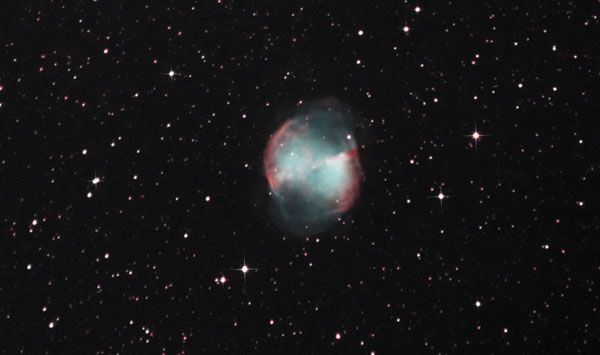
Westview Observatory
The Dumbbell’s central star is easier to spot than the Ring’s, but it’s still no walk in the park. The smallest scope I’ve seen it in was my husband’s erstwhile 140-mm refactor, employing a magnification of 300×.
Let’s move on to the Great Hercules Cluster (M13), a group of more than 200,000 stars about 23,000 light-years away from us. Most globular clusters are not confined to the disk of our galaxy but instead follow inclined orbits and spend much of their time in the galaxy’s halo. M13 is currently 15,000 light-years above the galactic plane.
M13 is visible as a small misty patch to the unaided eye in a dark sky or through binoculars in a suburban sky. The cluster is beautiful even at 37× in the 130-mm scope. It seems to sit on a line between two bright field stars: a 6.8-magnitude, yellow-orange star to the east and a white star just a half magnitude dimmer to the south-southwest. The hazy ball of light is flecked with barely resolved stars and otherwise appears quite grainy. Its very faint halo spans about 15′. The cluster becomes suddenly brighter within a diameter of about 8′ and is a bright, speckled haze within 4′. At 102× a large halo of pinpoint stars surrounds a dense core adorned with glittering flecks tangled in the fleecy glow of unresolved suns. Eye-catching star chains spring mostly from the southwestern half of the bright region and droop toward the white star. The bright region is wonderfully resolved at 164×. It flaunts a greater range of star magnitudes than most globulars and evokes a mound of glittering sugar.
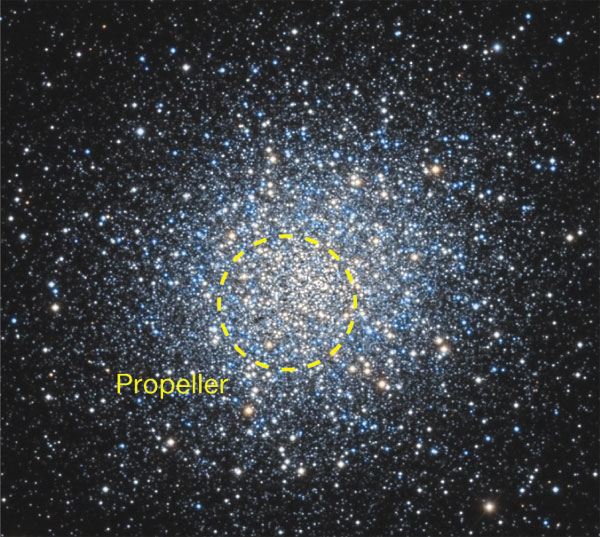
Sergio Kaminsky
Dusky lines arranged like a three-bladed propeller overlay the southeastern part of M13. They’re visible through my 10-inch reflector at 219× and smack-in-the-face obvious through the 15-inch at 192×. Two of the blades cradle the cluster’s bright interior, and the third strikes out away from the cluster, where it may be invisible if your view doesn’t expose enough stars to backdrop it. The propeller was first brought to light in a sketch by Bindon Stoney, who was in charge of Lord Rosse’s Birr Castle observatory in the mid-1800s.
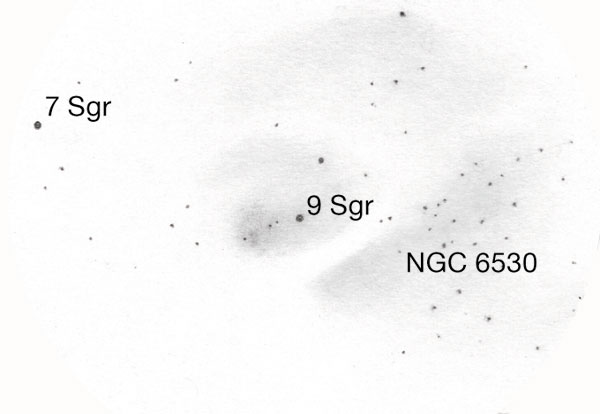
Sue French
Next we’ll visit the gorgeous Lagoon Nebula (M8), named for the darkling channel within, like a shadowy bay lapping on a silver shore. In a fairly dark sky, this emission nebula is readily visible to the unaided eye as a misty patch hovering above the spout of the Teapot asterism formed by the brightest stars of Sagittarius. My sketch shows the view through my 130-mm refractor at 48×. No filter was used when placing the stars, but a narrowband filter was added to help define the nebula. The ebony lagoon divides the nebulosity enveloping the open cluster NGC 6530 from the section harboring the brilliant but tiny double-knot of nebulosity called the Hourglass. The two sections are crowned by fainter bands of mist to their north. The brightest star within the nebula is blue-white 9 Sagittarii, and just off M8’s western side, 7 Sagittarii shines pale yellow.
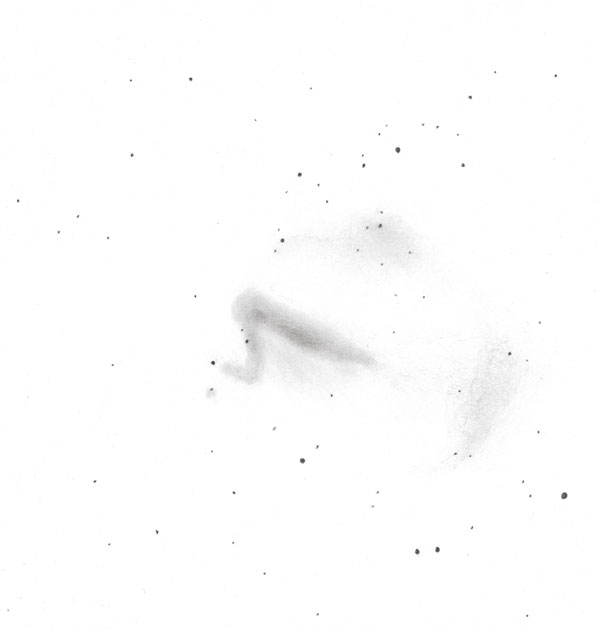
Sue French
Another captivating nebula in Sagittarius that begs for a sketch is the Omega Nebula (M17), though I’ve always preferred its alternate nickname, the Swan Nebula. One look at its most prominent feature brings to mind a celestial swan floating on the dark waters of the night. Beyond the figure of the swan, large swaths of diaphanous haze wrap around the swan’s body. An O III or a narrowband filter makes the nebula stand out better, and each was used to refine the nebulosity on my sketch. Surrounded by its full retinue of stars, the swan is also enchanting without a filter.
We’ll wind up this month’s tour with a drawing of the Butterfly Cluster (M6) in Scorpius. It was a faint daub of light to the unaided eye when I sketched this lovely pile of jewels with my 130-mm refractor at 48×. Its brightest star is the irregular variable BM Sco, which looks yellow-orange through the telescope. Its magnitude range is about 5.3 to 6.5. While a sketch can’t compare to a nice personal view or photo, it gives a good idea of the relative brightness of the stars. The Butterfly Cluster is so named because many of its stars seem to outline four wings, with perhaps even a head and antennae to the northwest. Can you picture our star-spangled lepidopteran?!
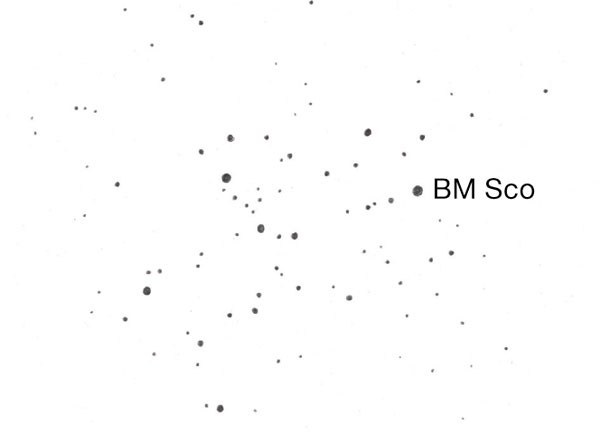
Sue French
This article first appeared in print in Sky & Telescope's July 2017 issue.
 0
0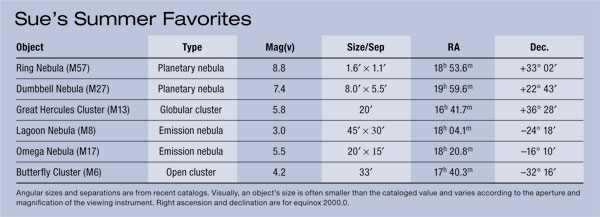









Comments
You must be logged in to post a comment.